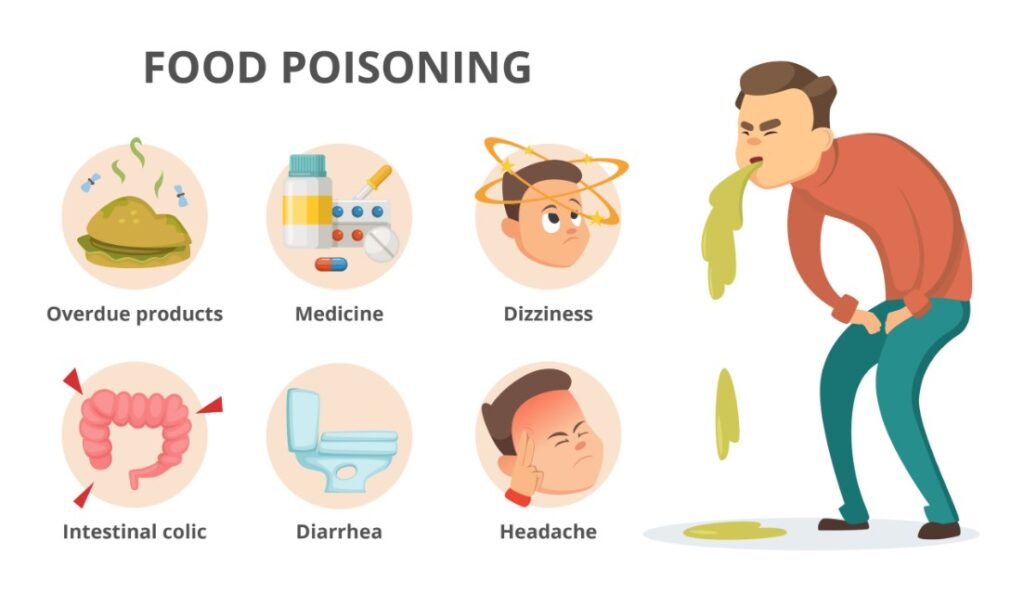Food poisoning is an ailment that the majority of people experience at one or the other in a given year in the USA. Regardless of whether it has been ingested through food, most bacteria, viruses or even toxins can lead to food poisoning and cause different levels of ailment. Welcome to this article where we will take your hand and lead you all through the primary stages of food poisoning, the symptoms, treatments as well as some basic questions about the condition. It will also offer a discussion of the place of humanistic health practices in healing and advice on how to get better.
What Is Food Poisoning?

Food bias is a condition where an organism takes ill after consuming contaminated food or drinks. The contaminants could be bacteria (for example Sarah mella, E.coli) , viruses (for instance norovirus), parasites(for example Giardia), or toxins (for instance bong krekic acid). Some of these pathogens or chemicals enter the digestive system and compromise digestion and absorption of foods hence resulting in such symptoms as nausea vomiting, diarrhea and abdominal pain.
How Long Does Food Poisoning Last?
The time taken by the food poisoning may vary depending on the cause of the poisoning. Normally, the signs of food bias commonly take between one to three days to manifest fully with some of the less severe signs taking as little as one day to develop. Nevertheless, certain foodborne diseases may take longer to clear and may therefore need the intervention of a doctor. For instance, a Salmonella or E.coli disease attributed to contaminated foods can take several days to heal completely. In essence, knowledge of how long food bias lasts may get you to know whether or not to seek medical attention.
Symptoms of Food Poisoning
The first step in dealing with the food poisoning is understanding that there some symptoms that would guide the treatments process.• Diarrhoea which may be grossly bloody at timesg is crucial for determining the next steps in treatment. Common symptoms include:
• Nausea and vomiting
• Diarrhea (which can sometimes be bloody)
• Abdominal cramps and pain
• Fever (in some cases)
• Headache and muscle aches
Symptoms tend to show within a few hours of having foodborne bacteria or viruses but inestimable bacterial or viral pathogens may take up to 2 days to show symptoms. You need to see a doctor right away if you get worse, for instance, have a high fever, constant vomiting or diarrhea that lasts for several hours, or signs of dehydration like dry throat or mouth, dizziness, or passing less urine compared to usual.
Bongkrekic Acid Food Poisoning
Bongkrekic acid is a toxin that comes from spoiled fermented foods including tofu produced with mold on soybeans and recognized to possibly cause a rare but deadly sort of food bias. Bongkrekic acid toxicity is associated with muscle weakness, hepatic toxicity, and in severe cases death. The risk associated with the spoiled ferments themselves is actually relatively rare as a cause of food poisoning, nonetheless it is essential to know about the dangers related to the consumption of the spoiled ferments to be able to avoid getting sick from food poisoning.
For more on food safety, go to the FDA’s food safety for food safety guide.
Treatment and Medication for Food Poisoning
Most food bias cases are mild and go away by themselves but treatment can help to reduce the severity of the symptoms and shorten the duration of the illness. Here are some key strategies for managing food poisoning:
1.Hydration is Key
The fourth method or maybe the most crucial factor of the food poisoning treatment is rejuvenation. Diarrhoea and vomiting are causes of dehydration and makes the diseases worse. Take as many fluids as possible, including water, ORS solution or clear soups. Do not consumed beverages such as sodas, tea or coffee since they contain components that aggravate the situation of dehydration.
2. Supportive Therapy
In mild cases of food poisoning, the treatment usually requires no more than support. This means giving the body the chance to recover alongside ensuring that one takes enough water. If the symptoms are extreme they require medical attention particularly if the may lead to dehydration or the condition complicates.
3. Antiemetics and Antidiarrheal Medications
Sometimes it is possible to use drugs such as ondansetron to prevent nausea and vomiting if they occur. However, there are some medications that should be used carefully; for example anti diarrhea agents including loperamide (Imodium). Although they help lessen the incidence of diarrhea, they can lengthen some illnesses for in doing so, they also may keep certain pathogens from being cleared by the body. This is true because different individuals might have different body reactions to the substances and so they should seek medical advice from a doctor before taking any substance.
4. Antibiotics
Sometimes they are, for example in bacterial food poisoning by Salmonella or Campylobacter antibiotics may be required. Still, antibiotics have no ability to treat viral illnesses, including norovirus, and may prove to be toxic if consumed inappropriately. Depending on the cause of your food poisoning, your doctor will advise if he prescribes an antibiotic or not.
However if you have any doubts concerning the treatment measures, the best thing to do is seek counsel from a specialist. For more specific advice about the treatment of food poisoning consult the more experienced sites such as WebMD.
Is Food Poisoning Contagious?

Food poisoning in this case is however not infectious but the bacteria or viruses causing the food poisoning is easily communicable through direct contact and food. For example, the vomiting and diarrhoea causing norovirus is easily transmitted through contacting surfaces, water and food. One cannot fail to mention the measures that could be taken such as washing hands with soap and water and other measures such as disinfecting surfaces.
For further information on avoiding food borne illness see CDC’s food safety tips.
Maryland Seafood Food Poisoning: A Case Study
A relanted event in Maryland clearly illustrated the possible negative impacts of seafood food borne illnesses; particularly from shellfish. In the case of Vibrio bacteria, food especially seafood, if contaminated poses severe condition in gastrointestinal tracts and, in some cases severe conditions that are life threatening to people with weakened immune system.
To avoid food poisoning that originates from sea foods, it is very essential to buy sea foods from reputable vendors and chefsneed to make sure they cook sea foods to the correct temperatures. Concern yourself with any recall from FDA or any local health departments on seafood.
What Does Food Poisoning Feel Like?
When it comes to food poisoning, you may experience some stomach discomfort, nausea; these are symptoms that are in a way affiliated to cramping and diareah. Actually, it may develop suddenly and reach its severity in the first few hours after consuming the products. For many, it presents like a very severe case of stomach flu, and that’s why people are likely to mistake food poisoning for a stomach bug.
How Soon After Food Poisoning Do You Vomit?
The time taken from the consumption of contaminated food and vomiting can take several hours though they may seldom take long. They pointed to the vomiting as the body means of ridding itself of substances which are dangerous to the stomach. In case you have problems like vomiting as well other symptoms, the best thing is to stay idle and drink as much as you can.
What to Eat After Food Poisoning
And if you start to feel better, you know, gradually begin to ease back into eating.” Start with bland, easily digestible foods like:
• Toast or crackers
• Rice or plain pasta
• Bananas
• Applesauce
Stay away from spicy foods, greasy or foods with the high content of dairy products until your digestive system has bounced back.
Food Poisoning vs. Stomach Bug
So often it is hard to differentiate between food poisoning and a simple stomach virus, although the two are in fact completely different. Food poisoning is generally caused by contaminated food or drink while the stomach bug is generally caused by virus. Both can lead to similar effects like nausea, vomiting and diarrhoea, but poisonings related to food will develop within a few hours of consuming the particular food stuff.
Food Poisoning Timeline
This article also outlines the time that is usually taken by food poisoning and the recommended way to deal with the symptoms. After consuming contaminated food:
• First few hours: Nausea, vomiting, and cramps are usual manifestations that manifest 1 to 6 hours after ingestion.
• 24-48 hours: Carrying capacity may be attained, diarrhea may commence and symptoms reach a climax.
• 3-7 days: Todays most food poisoning cases leave the body on its own but the severe ones may warrant some form of treatment.
FAQs
Q: Which foods are most likely to cause food poisoning?
A: Some of the most common sources include bacteria such as salmonella ,escherichia coli, viruses such as noroviruses and young and parasites. Spoilt foods themselves contain such toxins such as the bongkrekic acid which can cause food poisoning diseases.
Q: What measures can be taken to avoid getting a food borne illness?
A: This includes practice and observance of various measures in the management, preparation, and preservation of foods. Especially, wash your hands often, nicely cook meats and avoid foods from questionable sources.
Q: Can food poisoning be fatal?
A: However, in extreme circumstances, it might cause death and this is common with children, the sick and the elderly.
To learn more information about how to prevent, avoid, or treat food poisoning visit reliable websites such CDC.
Final Decesion
Pestilence From tainted edibles is a weave that is as popular as it is avoidable. With early identification of the symptoms, and regular intake of water, most can be treated to normalcy. If the symptoms are very intense or if they last for more than 3-5 days, then one needs to consult a doctor. To learn more about gut health and other important food safety concerns, please visit the fitcareness.com blog for more health articles!
Lastly, always adopt proper handling and preparation of foods, check on the food recall list and if you suspect you are affected by food borne diseases, consult your doctor immediately. Stay healthy, stay safe!
Read More
- How to Make Soup at Home: A Complete Guide to Delicious and Nutritious Soups

- How to Make Recipes with Chicken Breast, Potatoes, and Onions in the Oven

- Healthy Fast Food Near Me: How to Find Healthy Fast Food Near Me Open Now

- Juice Cleanse: How to Make a Juice Cleanse at Home & Whole Foods

- Aloe Vera Juice: How to Make the Best Drinking Aloe Vera Juice


